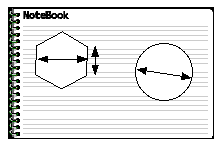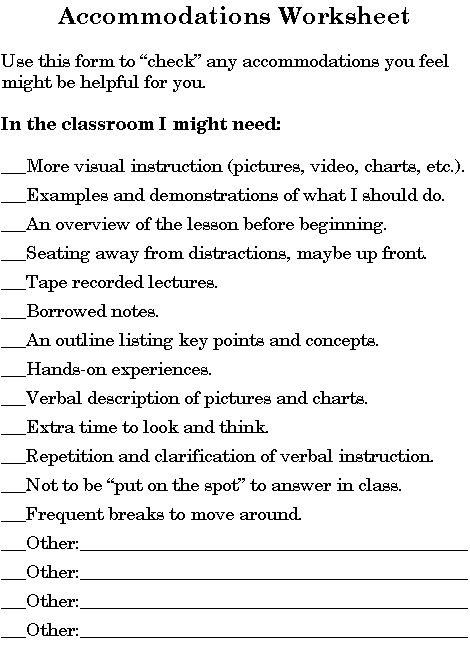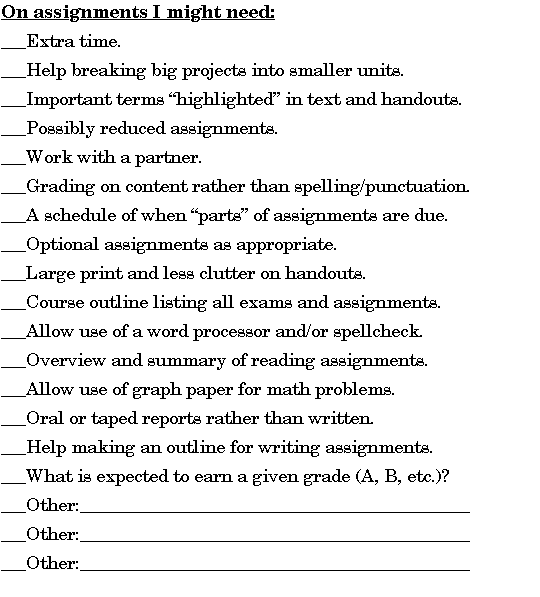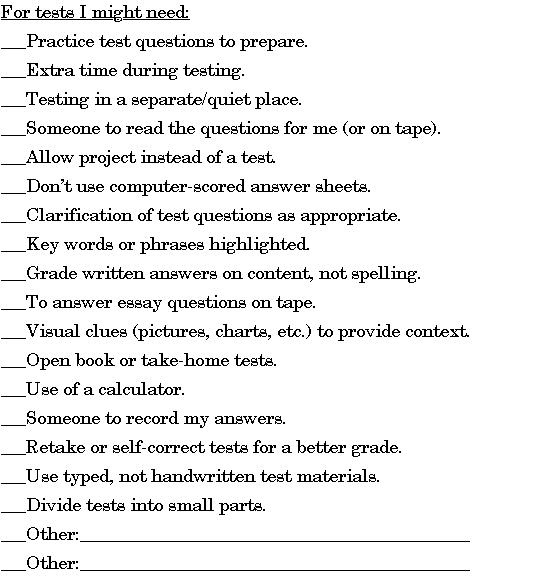Using Accommodations to Help You Learn
Words to know for chapter 8:
Accommodation - something to make learning easier
Compensate - using a strength to make up for a weakness
Benefit - take advantage of something
Overview - the 'big picture'
Summary - the most important parts
Simplify - make it easier
Clarify - make it clearer
Supplement - additional information
Repetition - repeating what has already been taught
Modify - change
Context - the circumstances surrounding a situation
Concrete - simple, basic, easily understood

'By now you should have a pretty good idea about how your 'processing disability' interferes with your ability to learn. But, just understanding the problem doesn't really help much. There is still more to the mystery of your learning disability! What you really need to know is what you and your teachers can do to help yourself learn better.'
Important!!! When you have a learning disability you have a legal right to appropriate and necessary accommodations in order for you to learn.
This means that your teachers may need to modify tests/assignments or change the way that they present information to you. But, they are only required to provide accommodations that you really 'need'.
Appropriate accommodations should either help you learn better or give you a better way of demonstrating your knowledge.

Accommodations should not simply give you an easier way to get better grades.
For example, you may feel that a math test would be easier if you could use a calculator (who wouldn't?). And sometimes, the use of a calculator is a very appropriate accommodation. But other times, using a calculator may not allow the teacher to find out how well you really understand your math.
This is all about team work between you and your teachers.

It is up to your teacher and casemanager (along with help from you and your parents) to determine what accommodations you really need for each situation.
You can be very helpful in deciding what might be an appropriate accommodation. So don't hesitate to tell your teacher or casemanager what you think you might need.
Most LD students can benefit from very similar accommodations such as:
- extra time
- reduced distractions
- outlines
- overviews/summaries
- hands-on activities
- borrowed notes
- shortened assignments
But, each type of learning disability (area of processing difficulty) requires these (and other) accommodations for different reasons. It is important to understand the reason for each accommodation so that you can use it to your best advantage.
Know Your Learning Strengths!!
We have spent a lot of time finding out how your processing weakness interferes with learning. But now we need to explore your processing strengths to find out how you learn best.

Don't forget, although you have a processing weaknessthat interferes with your learning, you also have many areas of strength that can help you to 'compensate' for your difficulties.
For example, a blind person learns to use their other senses (like hearing, touch, smell, taste) in order to compensate for not being able to see.
It is the same for a person with a learning disability. Your natural learning strength or 'preference' is just the opposite of your processing weakness. So someone with a visual processing disability has a natural 'preference' for auditory learning. Someone with a sequential processing weakness will learn best through their conceptual processing channel.
Find your area of processing disability below to start learning how certain accommodations and 'compensation methods'can help you learn.
Visual Processing DisabilityAuditory Processing Disability
Sequential Processing Disability
If you have trouble with visual processing you will naturally learn best with auditory information. But there is going to be a lot of important visual information that you can't get through your ears.
So visual information will need to be simplified, clarified, and supplemented with information through your stronger senses (auditory, touch, smell, taste).
You may need to ask for some of the following 'accommodations' from your teacher:
1. Extra time to look at visual information
(pictures, videos, writing on the board, etc.).![]()
2. Worksheets and tests with larger print and less 'clutter'.
3. Verbal description to help understand visual information.
4. Borrowed notes so that you can spend more time 'looking'.
5. Maybe do math problems on graph paper to keep numbers in line.
6. Extra time for reading and writing tests and assignments.
7. A clear and simple overview or summary of what will be learned before each lesson so that some of the confusing visual information can make more sense.
8. Textbooks and assignments with highlighting of the most important information.
9. Hands-on experiences to use your other senses and 'haptic processing' skills to learn.
10. Reduced assignments to avoid feeling overwhelmed.
11. Books and assignments on tape.
12. Testing in a quiet area to avoid distractions.
13. Provide an alternative to computer-scored answer sheets (the small boxes or circles can be very visually confusing).
14. Grade written assignments/tests on content rather than spelling or punctuation.
15. Use of a calculator or 'spell check' when
appropriate.
And here are some things you can do for yourself:
1. Take more time 'visualizing' letters, words and numbers for spelling and math.
2. Listen, listen, listen for any information you may need.
3. Ask for explanation when you don't understand visual information.
4. Make lists of assignments.
5. Read out loud to yourself so that you can hear what you are trying to learn.
6. Take time to break large assignments into smaller (manageable) pieces.
7. Make a schedule of when different pieces of an
assignment should be done.
8. Draw simple pictures to help solve math story problems.
Auditory Processing Disability:
If you have trouble with auditory processing you will naturally learn best with visual information. But there is going to be a lot of important auditory information that you can't get through your eyes.

So auditory information will need to be simplified, clarified, and supplemented with information through your stronger senses (visual, touch (haptic), smell, taste).
You may need to ask for some of the following 'accommodations' from your teacher:
1. Repetition and clarification of verbal
instruction (the more you hear it, the better you will learn
it).
2. Important information to be drawn or at least
written on the board.
3. Extra time for reading and writing tests and assignments.
4. Seating near the front of the class to maintain auditory attention and minimize visual distraction.
5. Visual information (pictures, videos, graphs, charts, etc.) to help understand verbal information.
6. A clear and simple overview or summary of what will be learned before each lesson so that some of the confusing auditory information can make more sense.
7. Textbooks and assignments with highlighting of the most important information.
8. Hands-on experiences to use your other senses and 'haptic processing' skills to learn.
9. Reduced assignments to avoid feeling overwhelmed.
10. Testing in a separate room to avoid visual distractions.
11. Provide examples and demonstrations of what is expected from assignments and projects.
12. Don't 'put me on the spot' by asking questions in class unless I volunteer.
13. Modified or reduced foreign language requirements.
And here are some things you can do for yourself:
1. Use your stronger visual skills to 'visualize'
information as you hear it.![]()
2. Listen, listen, listen for any information you may need. You will need to pay more attention to verbal information than other students.
3. Ask for explanation when you don't understand verbal information.
4. Make lists of assignments - maybe with pictures.
5. Take time to break large assignments into smaller (manageable) pieces.
6. Make a schedule of when different pieces of an assignment should be done.
7. Draw pictures to help solve math story problems.

Sequential/organizational disability:
When you have a weakness in the sequential/organizational area, you have difficulty organizing and memorizing details in your head. You and your teachers will need to find other ways for you to remember and organize important information.
In addition, your natural strength (to use for compensation) is your conceptual/holistic processing skills. You probably will learn best when you can see the 'big picture' and may have a rather deep understanding even if you can't remember all the 'details'.
You may need to ask for some of the following 'accommodations' from your teacher:
1. Providing the 'big picture' through summaries and overviews before breaking a lesson into smaller parts.
2. Important facts and details to be drawn or at least written on the board.

3. Extra time for reading and writing tests and assignments.
4. Seating near the front of the class to maintain attention and minimize distraction.
5. Visual information (pictures, videos, graphs, charts, etc.).
6. Use real-life examples to help with the 'big picture' and show why this lesson is relevant.
7. Textbooks and assignments with highlighting of the most important information.
8. Hands-on experiences to use your other senses and 'haptic processing' skills to learn.
9. Reduced assignments to avoid feeling overwhelmed.
10. Testing in a separate room to avoid distractions.
11. Provide examples and demonstrations of what is expected from assignments and projects.
12. Don't expect quick answers. Allow extra time for organization of thoughts.
13. Grade writing assignments on content rather than 'mechanics'.
14. Allow the use of 'spell check' when appropriate.
15. Modified or reduced foreign language requirements.
And here are some things you can do for yourself:
1. When reading, read summary sections and review questions first to give you a better idea of what you will be learning.
2. When writing, just get your main, important ideas down before going back to fill in the details. Outlining can really help!
3. Ask for explanation when you don't understand the details.
4. Make lists of assignments - maybe with
pictures.
5. Take time to break large assignments into smaller (manageable) pieces.
6. Make a schedule of when different pieces of an assignment should be done.
7. When memorizing details, combine words with music or rhythm to provide a more 'conceptual feel'.

Conceptual/Holistic Processing Disability:
When your weakness is in the conceptual/holistic area, you probably can memorize details and facts pretty well but really struggle to understand deeper meaning and general concepts. You may read rather quickly and easily but have difficulty understanding what you have read.
For this type of disability it is most important to take extra time to try to develop a deeper understanding of what you are learning. Although you may finish assignments quickly, you need to spend extra time to figure out why each assignment was important and what you really learned.
You may need to ask for some of the following 'accommodations' from your teacher:
1. Extra instruction about underlying concepts and deeper meaning. Why is this information important?
2. Overviews and summaries to provide context before and after lessons.
3. Concrete visual aids (drawings, charts, video, etc.) to help understand the 'big picture'.
4. Extra time for thinking through tests and
assignments.
5. Textbooks and assignments with highlighting of the most important information and concepts.
6. Hands-on experiences to use your other senses to learn.
7. Reduced assignments to avoid feeling overwhelmed.
8. Concrete examples and/or demonstrations.
9. Linking information to real-life situations.
10. Encouragement to go beyond superficial understanding.
11. Clarification and repetition of concepts.
12. Outlines listing key points and concepts.
And here are some things you can do for yourself:
1. Take more time searching for deeper meaning after completing assignments.
2. Pay attention, watching and listening for any important information you may need.
3. Ask for explanation when you don't understand concepts or meaning.
4. When reading, stop after each paragraph to see if you really understood what you read.
5. Take time to break large assignments into smaller (manageable) pieces.
When you have a general weakness in the area of processing speed, information tends to fly right by before you have a chance to learn it. You will have a high need for extra time in class, for assignments, and during tests.
You probably have pretty good reasoning skills so that you can 'figure out' the information, but you will need extra time in order to do so.
You may need to ask for some of the following 'accommodations' from your teacher:
1. Extra time during class to think about the lesson that has just been presented.
2. Repetition of lectures and lessons through the use of audio or video tape.
3. Slower instruction - don't talk too fast.
4. Don't expect rapid answers or in-class discussion. Ask a question only if there has been plenty of time to think it through.
5. Provide the 'big picture' through summaries and overviews before breaking a lesson into smaller parts.
6. Important facts and details to be drawn or at least written on the board.
7. Extra time for reading and writing tests and assignments.
8. Seating near the front of the class to maintain attention and minimize distraction.
9. Use real-life examples to help with the 'big picture' and show why each lesson is relevant.
10. Textbooks and assignments with highlighting of the most important information - there may not be time to read everything.
11. Hands-on experiences to use your other senses and 'haptic processing' skills to learn.
12. Reduced assignments to avoid feeling overwhelmed.
13. Testing in a separate room to avoid distractions.
14. Provide examples and demonstrations of what is expected from assignments and projects.
15. Grade writing assignments on content rather
than 'mechanics'.
14. Allow the use of 'spell check' when appropriate.
And here are some things you can do for yourself:
1. When reading, read summary sections and review questions first to give you a better idea of what you will be learning.
2. When writing, just get your main, important ideas down before going back to fill in the details. Outlining can really help!
3. Ask for explanation when you don't understand!
4. Make lists of assignments - maybe with pictures.
5. Take time to break large assignments into smaller (manageable) pieces.
6. Make a schedule of when different pieces of an assignment should be done.
7. When memorizing details, combine words with music or rhythm to provide a more 'conceptual feel'.
What about Learning Style?

You may hear teachers talking about 'learning Style' and about how all students have their very own style of learning. A lot of the things you may hear about learning style will sound very much like what you are discovering about your learning disability. This is because many learning style theories involve the same (or at least very similar) areas of 'processing' as we are exploring. But learning style is actually quite different from a learning disability.
As you have learned, a learning disability involves a weakness in the way you process information. So with LD you have very definite processing strengths and weaknesses which control how you learn.
Learning style really involves how your 'personality' affects learning. In other words, learning style refers to what types of things you enjoy and how 'comfortable' you are in different types of learning situations. For most people, 'learning style' really has nothing to do with processing strength or weakness.
All students have their own learning style and may prefer to learn in certain ways. But a preferred learning style usually does not interfere too much with learning.
An example would probably help to show the difference between learning style and learning disability:
Whether you know it or not, you have a preferred foot that you almost always use for kicking (like a ball, your brother, etc.). But it isn't that your 'preferred' foot is stronger, it just happens to be the one you are most comfortable kicking with.
But what if one of your feet was much weaker than the other. You would certainly kick with your strong foot, not because of 'style' or 'preference', but because that is really your best (maybe only) choice.
That is the difference between style and disability!

When you have a learning disability, your preferred 'learning style' is very much controlled by your processing strengths and weaknesses. So you actually do have a very definite learning style. But for you it is much more than a 'preferred' way of learning. It may be the only way for you to really learn well.

'So, we have discovered that along with your learning disability you also have a very definite learning strength or 'preference'.
And we discovered how you can use your learning preference along with appropriate accommodations to 'counteract' your learning disability.'
'But remember, accommodations are only helpful if you use them wisely.'
Review questions:
1. True or false: You have a legal right to any accommodation that will help you get better grades.
2. Who can help determine the right accommodations for you?
3. What does the word 'compensate' mean?
4. Who can help you get accommodations that you feel you need?
5. What does the word 'simplify' mean?
6. What does the word 'clarify' mean?
7. True or false: Use of a calculator is never an appropriate accommodation.
8. True or false: 'Learning Style' is the same as 'Learning Disability'.



Return to the LDinfo Web Site to find out about any of the following topics (and more):
Learning disabilities - what is a learning disability (LD or SLD)?
Dyslexia: Dyslexia is a reading disability or reading disorder
Dysgraphia Dysgraphia is a writing disability or disorder
Dyscalculia Dyscalculia is a math disability or disorder
What is an attention deficit disorder (ADD, AD/HD, ADHD)?
Gifted LD: Can a student be gifted and LD?
Emotional/Behavioral issues and LD: Do LD students experience behavior problems or depression?
Section 504: What is a Section 504 plan?
What is special education?
What is processing?
What is a severe discrepancy?
What is a nonverbal learning disability (nonverbal LD or NLD)?
What is a central auditory processing disorder (CAPD)?
Uncovering the Mysteries of your Learning Disability
Order printed copies of this manual
- Chapter 1 - What is a Learning Disability?
- Chapter 2 - What Causes Learning Disabilities?
- Chapter 3 - Discrepancy = Underachievement
- Chapter 4 - Processing: The Sensory Channels
- Chapter 5 - Processing: The Cognitive Channels
- Chapter 6 - Processing: Sensory + Cognitive
- Chapter 7 - LD Jargon
- Chapter 8 - Using Accommodations
- Chapter 9 - Other Issues Related to LD
- Chapter 10 - Intelligence vs IQ
- Chapter 11 - Exercizing Your Weakness
- Chapter 12 - LD and the Law
- Chapter 13 - Becomming an Effective Self-Advocate
- Chapter 14 - Planning for Your Future
- Chapter 15 - The Summary
Copyright © 2006-2017 LDinfo Publishing
All rights reserved. Any reuse or republishing of the text
or images on this web site without prior written consent of
the copyright holder is prohibited.